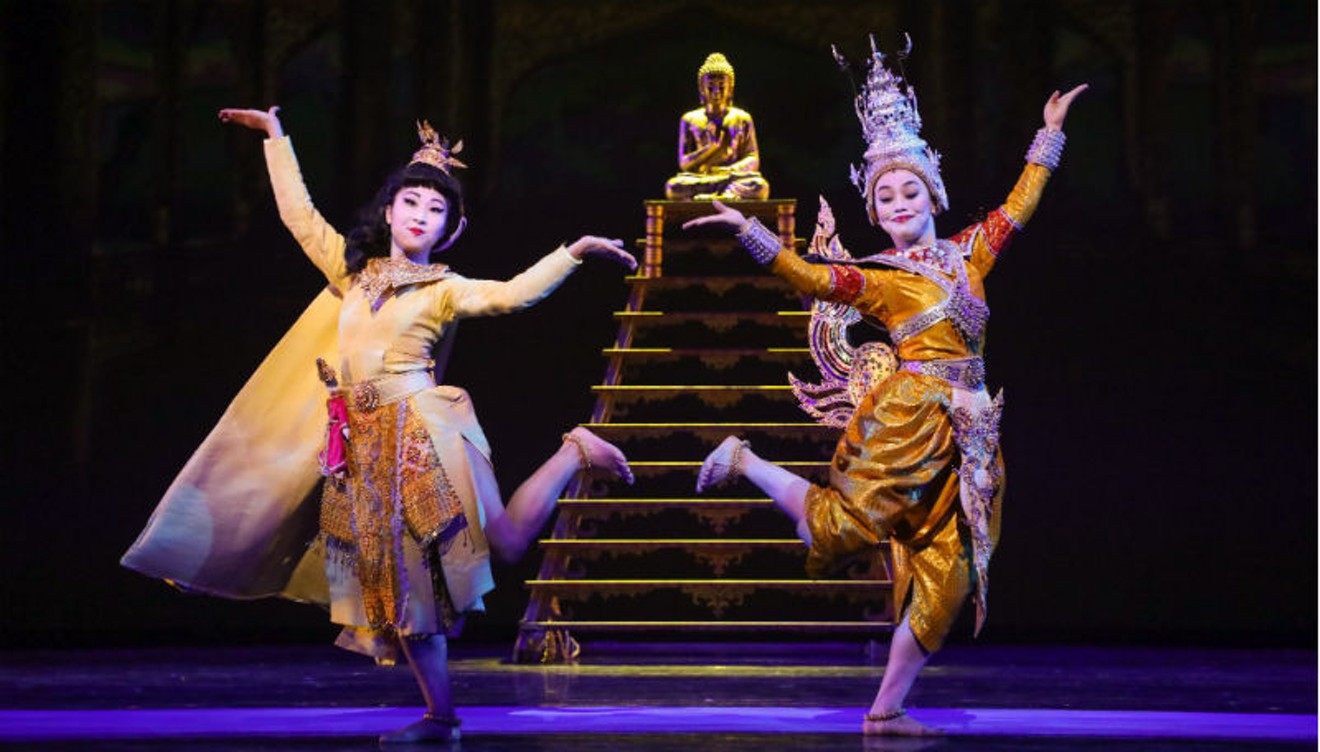There's no possible way to talk about the Broadway musical without praising one of its most incandescent luminaries, legendary director and choreographer Jerome Robbins. Without him, Broadway would be dim indeed.
One of Theatre Under the Stars' bright stars in this or any season is the Tony-winning anthology, Jerome Robbins' Broadway (1989), an electrifying smorgasbord of Robbins' most celebrated stagings.
The sheer joy and thrill of what it means to experience a “Broadway Show” permeates the theater.
As a kid Robbins so loved to dance (his sister was a member of modern dancer Irma Duncan's company) that he dropped out of college after his first year to study ballet – and any other type of dance he could find: Asian, abstract expressionism, Spanish, burlesque. All types fascinated him. He performed and choreographed in the Borscht Belt, with fellow gypsies Imogene Coca and Carol Channing, danced on Broadway under George Balanchine, and joined Ballet Theatre in 1940, where he created his jubilant WWII gem about three sailors on 24-hour shore leave in New York City, Fancy Free. The ballet with first-timer Leonard Bernstein's ebullient score was a smash hit and immediately inspired a full-length Broadway musical, rechristened On the Town. It, too, was a smash, and the career of Robbins was off and dancing.
For the next 30 years, he split his time between ballet and Broadway, choreographing and/or directing such diverse shows as High Button Shoes (for which he received the first of his five Tony awards), Call Me Madam, The King and I, The Pajama Game, Peter Pan, Bells Are Ringing, West Side Story, Gypsy, Fiddler on the Roof. It's a Who's Who of iconic shows.
What distinguishes a Robbins musical from many other works from the period – aside from the phenomenal songs and librettos he had to work with from polished pros Jule Styne, Bernstein, Rodgers and Hammerstein, Berlin, Comden and Green, young Stephen Sondheim, Harnick and Bock, Arthur Laurents – was the total integration of music, dance, and story. Any one of his dance routines distills the essence of the show in which it's featured. The whole concept is encapsulated in his rich, flavorsome movement. If it's High Button Shoes, set in pre-WWI America, there's lots of softshoe and Keystone Cops. The famous “By the Sea” number, stunningly recreated here, is a paean to silent film comedy, with madcap scurrying, crazed plotline, and bathhouse doors slamming like a Feydeau farce. It it's Peter Pan, the very act of flying is an ode to the wistful innocence and unbounded joy of childhood. If it's Fiddler, it's community and group formations, which coalesce against the outside world that threatens their “Tradition.”
Robbins was manic when creating. There are more horror stories about working for him than told about any other director/choreographer. He could be harsh, cold, unrelenting, and his style of browbeating and psychological maneuvers to get what he wanted from his dancers would not be tolerated today. Nevertheless, once the dancers survived his perfectionist's eye and the brutal overtime and months of rehearsal, they were amply rewarded with the best dance routines they would ever perform. Love him or hate him, one became a better dancer because of him.
Jerome Robbins' Broadway is replete with classic numbers, immaculately realized and brought to life. The peerless “Small House of Uncle Thomas” from The King and I, with its dazzling red-and-gold silks, stylized movement, and Rodgers' watercolor music, bursts into the Hobby as if newborn. The “Suite of Dances” from West Side Story is the highlight ending to the first act. It has those spring-loaded gang fights – all explosive, testosterone-filled leaps and pirouettes; its “Dance at the Gym” has rival Jets and Sharks outdoing each other in flashy slam moves before the brutal murders of Bernardo and Riff. In “Cool,” full of whispery, antsy admonitions that ratchet up the tension, the Jets wait anxiously before the big rumble. And then there's that heavenly conclusion to “Somewhere,” with troubled teens finding peace and harmony in the rosy glow of another Neverland. Robbins surpassed even himself in this ground-breaking show.
But then again he always did. Be they low-rent strippers in Gypsy, bumping and grinding; or randy sailors on the make in On the Town; or old-fashioned Ma and Pa gliding to 2/4 time in High Button Shoes; or the entire company frolicking to infinite jazz-baby variations on the Charleston in Million Dollar Baby; or the smoky rarity “Mr. Monotony” from Irving Berlin's Miss Liberty, cut in out-of-town tryout.
If you want to experience the glory of classic Broadway, and why it's such an essential part of our national consciousness, then Jerome Robbins' Broadway is required viewing. The cast is enormous (48, plus understudies and children for Peter Pan), the orchestra is lush with original orchestrations, and the sets, costumes, and lighting by Ryan McGettigan, Colleen Grady, and Jason Lyons, grandly echo their Broadway antecedents. As Mama Rose sings in Gypsy, Everything's comin' up roses. It's a grand bouquet.
However, TUTS' shows are notoriously plagued by sound problems. This show is no exception. Mikes cut out or are turned on too late. Sadly, modern theater lives by the mike. There are no Ethel Mermans anymore, and projection into the balcony is a lost art. Robbins lived for the lyrics; that, and the music, of course, was his inspiration for movement. He would be aghast at this haphazard approach.
The ensemble doubles and triples up roles, but the standouts include Jordan Beall, as innocent gob Gabey in On the Town; brassy Anne Brummel, as trumpet-strutting Mazeppa in Gypsy and Miss Liberty's Torch Singer sheathed in black velvet for “Mr. Monotony;” Gabriella Enriquez as fiery Anita in West Side Story; Akina Kitazawa, as indomitable Eliza in The King and I; Sean Rozanski, as hothead Bernardo in West Side Story; Teresa Zimmermann, as light-encrusted Electra in Gypsy and befuddled Golde in Fiddler; and Jeffrey Schecter, as Narrator, who then morphs into various roles, notably kind and exasperated Tevye from Fiddler. Everyone dances up a storm, exits, then reappears as somebody else, and continues dancing. It's non-stop and beautifully danced.
Jerome Robbins was one-of-a-kind: sacred monster, tortured genius, witty and charming, snake-like, but filled with unlimited inventiveness. He knew how to move. He made the music dance. He made the story dance. He made the Broadway musical dance. No one danced like he did. And no one since has danced any better.
Jerome Robbins' Broadway continues through June 9 at 7:30 p.m. Tuesdays through Thursdays and Sundays; 8 p.m. Fridays and Saturdays; and 2 p.m. Saturdays and Sundays at the Hobby Center, 800 Bagby. For information, call 713-558-8887 or visit tuts.com. $30-$104.50.
Support Us
Houston's independent source of
local news and culture
account
- Welcome,
Insider - Login
- My Account
- My Newsletters
- Contribute
- Contact Us
- Sign out
Jerome Robbins' Broadway at TUTS Shows Off the Master's Musical Theater Magic
D. L. Groover May 31, 2019 7:32AM

Akina Kitazawa as Eliza and Minami Yusui as Angel in the TUTS production of Jerome Robbins' Broadway.
Photo by Melissa Taylor
[
{
"name": "Related Stories / Support Us Combo",
"component": "11591218",
"insertPoint": "4",
"requiredCountToDisplay": "4"
},{
"name": "Air - Billboard - Inline Content",
"component": "11591214",
"insertPoint": "2/3",
"requiredCountToDisplay": "7"
},{
"name": "R1 - Beta - Mobile Only",
"component": "12287027",
"insertPoint": "8",
"requiredCountToDisplay": "8"
},{
"name": "Air - MediumRectangle - Inline Content - Mobile Display Size 2",
"component": "11591215",
"insertPoint": "12",
"requiredCountToDisplay": "12"
},{
"name": "Air - MediumRectangle - Inline Content - Mobile Display Size 2",
"component": "11591215",
"insertPoint": "4th",
"startingPoint": "16",
"requiredCountToDisplay": "12"
}
,{
"name": "RevContent - In Article",
"component": "12527128",
"insertPoint": "3/5",
"requiredCountToDisplay": "5"
}
]
KEEP THE HOUSTON PRESS FREE...
Since we started the Houston Press, it has been defined as the free, independent voice of Houston, and we'd like to keep it that way. With local media under siege, it's more important than ever for us to rally support behind funding our local journalism. You can help by participating in our "I Support" program, allowing us to keep offering readers access to our incisive coverage of local news, food and culture with no paywalls.
D.L. Groover has contributed to countless reputable publications including the Houston Press since 2003. His theater criticism has earned him a national award from the Association of Alternative Newsmedia (AAN) as well as three statewide Lone Star Press Awards for the same. He's co-author of the irreverent appreciation, Skeletons from the Opera Closet (St. Martin's Press), now in its fourth printing.
Contact:
D. L. Groover
Trending Arts & Culture
- Desperate Lives Buoyed By Dylan's Songs in Girl From the North Country
- The Story Stalls But The Beat Goes On in The Cher Show at TUTS
- Top 5 Sickest Stephen King Sex Scenes (NSFW)
-
Sponsored Content From: [%sponsoredBy%]
[%title%]

Don't Miss Out
SIGN UP for the latest
arts & culture
news, free stuff and more!
Become a member to support the independent voice of Houston
and help keep the future of the Houston Press FREE
Use of this website constitutes acceptance of our
terms of use,
our cookies policy, and our
privacy policy
The Houston Press may earn a portion of sales from products & services purchased through links on our site from our
affiliate partners.
©2024
Houston Press, LP. All rights reserved.





